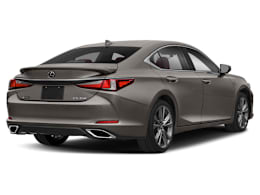The ES is a rewarding choice for a road trip thanks to its absorbent ride and indulgent interior. But fussy controls keep this luxury sedan just short of ideal. As before, two versions are available: the standard V6-powered ES 350 and the ES 300h hybrid, which uses a four-cylinder engine. Lexus gave the V6 more power for 2019, although fuel economy stays the same at 25 mpg overall. The V6 accelerates smoothly, and shifts are hardly noticeable. We tested the hybrid powertrain in the similar Toyota Avalon and got an impressive 42 mpg.
Shoppers who are drawn to the ES because of its reputation as a cushy cruiser won’t be disappointed. The cabin remains hushed and the suspension steadily smooths out rough roads. At the same time, the car handles better than its predecessor, with responsive steering and restrained body lean. That said, it’s still not in the sports sedan league of, say, the BMW 3 Series or Infiniti Q50.
The more aggressive exterior styling of the ES may be polarizing, but there’s no debate over how the new look affects its livability. The car’s lowered stance and sloping roof reduce headroom for taller drivers and make it harder to get in or out. Those in the rear seat benefit from decent legroom, but there's marginal headroom because of that roofline.
The high-quality interior has plenty of soft-touch leather surfaces, and its attractive interior design touches add warmth. The ES is offered with a choice of a standard eight-inch infotainment screen or an optional 12.3-inch screen that comes with a navigation system. It is the first Lexus model to have Apple CarPlay connectivity along with Amazon Alexa voice control. Changes for 2020 include standard Android Auto. We found the infotainment system’s touchpad controller distracting to use.
The impressive list of standard safety equipment includes automatic emergency braking with pedestrian detection, lane keeping assist, and lane departure warning. But blind spot warning is optional.


























